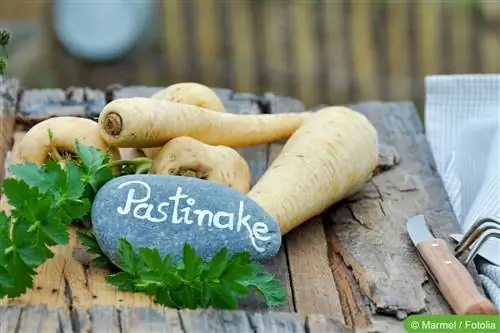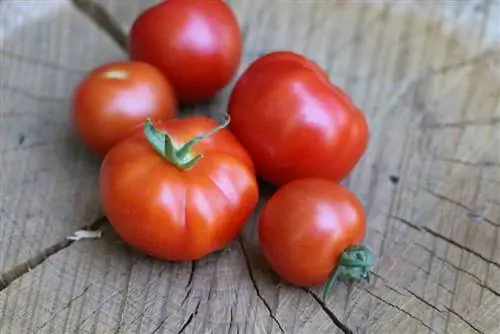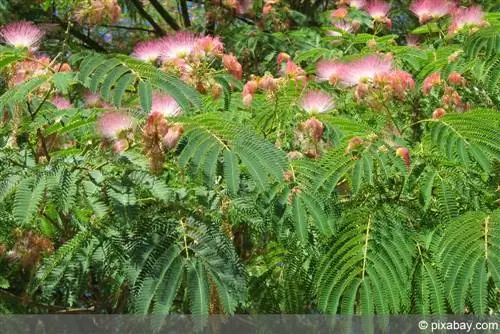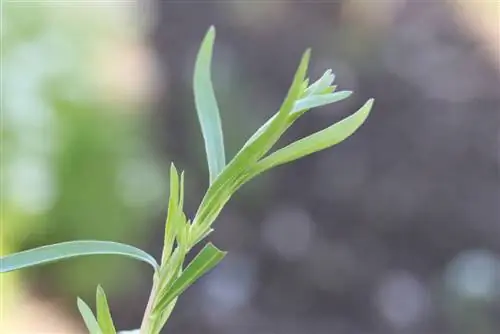- Author admin [email protected].
- Public 2023-12-17 03:39.
- Last modified 2025-01-24 12:45.
The parsnip, also known as mutton carrot or Germanic root, is an ancient root vegetable. Until well into the 18th century, it was a winter staple for most of the population, but was then replaced by potatoes and carrots. About twenty years ago, parsnips experienced a revival thanks to organic farming and are now available almost everywhere at weekly markets and grocery stores. Growing it in the garden requires little care and is therefore worthwhile for parsnip lovers. There are now countless recipes for these delicious winter vegetables.
General information about parsnips
The parsnip is a root vegetable that is related to carrots and, like carrots, belongs to the umbelliferous family. Two types are known: Vegetable parsnip, Pastinaca sativa, it is an annual and has a thick, long root, is grown commercially and by hobby gardeners
Meadow parsnip, Pastinaca sativa pratensis, it grows wild in meadows, on field verges and on dry slopes, is usually biennial and its roots are thinner. In the past, the meadow parsnip was also used in the kitchen. The white-yellowish root of the parsnip is easily confused with the parsley root. In contrast to this, however, it has a sweet, aromatic and spicy taste. Its high content of essential oils, minerals and vitamins makes it a valuable vegetable that also contains very little nitrates. The root is used for creamy soups, purees, steamed or baked as a side dish, grated raw as a salad and particularly appreciated by connoisseurs as parsnip chips, and fried in thin slices in oil. If the culture period is long enough, the parsnip root can grow up to 20 cm long and around 7 cm thick with weights of 100 to 1200 grams.
Location and soil requirements
In a predominantly sunny location, the parsnips do very well with humus-rich, heavy to loamy soil. Moor soils are also favorable. The pH value should be between 5.5 and 7.0. It is important that the soil is loosened well and deeply so that the roots can grow straight and do not branch out. As with carrots, do not incorporate fresh manure or unripe compost into the soil as this will attract pests. Mature compost or natural fertilizer are well suited as the first fertilizer application when sowing.
Sowing and care
When sowing parsnips, pay attention to crop rotation. They must not follow other umbelliferous plants such as carrots, parsley, lovage, fennel, anise, dill or caraway in the bed. It is sown early. Depending on the weather, from mid to late March. However, sowing is possible until June. However, the later the seeds are sown, the smaller the roots remain. A sowing depth of 2 cm at a distance of around 10 cm is ideal; the row spacing should be at least 35 cm. The seeds need 15-20 days to germinate with consistent moisture. In regions at risk of frost, the bed can be covered with fleece or foil, as the shoots tend to shoot when exposed to cold. Even if the spring has a lot of rain, a cover is recommended, as too much moisture causes growth to stagnate. When the plants are around 10-15 cm high, they receive another moderate dose of fertilizer. Regular watering is important from June to September. This promotes growth, prevents the roots from bursting and soil crusting. However, waterlogging should be avoided! During the growing season, in addition to watering and one-time fertilization, careful hoeing and weeding are only necessary every now and then for care. With 30 plants per square meter, the harvest yield is approximately 6-8 kg.
Harvesting and storage
From October, after a cultivation period of 180-200 days, the roots can be harvested. To do this, loosen the soil with a digging fork and carefully pull out the parsnips. The leaves are then cut down to one centimeter and the roots are stored in sand at around 0 degrees and high humidity. If stored for too long, the taste becomes somewhat bitter. The leaves can be used fresh or dried to flavor soup stocks. Depending on use, parsnips can also be cut into strips or cubes, blanched and frozen after harvesting. Since the roots are completely hardy, you can leave them in the bed and harvest them on frost-free days if necessary. However, they are a treat for mice and voles, so it is advisable to remove them from the ground in late autumn.
Pests and diseases
In terms of pests, parsnips can be attacked by carrot flies and aphids. Therefore, you should neither use fresh manure nor unripe compost when preparing the soil. In order to prevent diseases such as carrot blackness, powdery mildew and root scab, crop rotation must be observed. Ideally, parsnips are sown on a bed where onion plants, green manure or mint plants previously grew. If diseases and pests get out of hand or if you want to specifically prevent them, biological or chemical agents can be used to combat them, depending on your preference.
Conclusion
- Parsnips are a fine winter vegetable that is easy to grow in the garden
- Care does not require much effort
- The root vegetables can be stored well after harvesting
- The taste of parsnips is sweet and aromatic and the root can be used in many ways in the kitchen
- Due to its high content of essential oils, vitamins and minerals, it is a he althy winter vegetable
Cultivation in key points
- The parsnip is a biennial plant.
- It grows well in loamy soil. Boggy soils are also well suited.
- A high humus content is important so that the parsnip tastes aromatic.
- Acidic soils must be limed!
- A pH value of 5.5 to 7 is ideal.
- The soil must be deeply loosened!
- In light soils, incorporate mature compost before sowing!
- Waterlogging should be avoided!
- Parsnips can be sown directly outdoors from March. Frost seeding is possible.
- The planting distance should be 6 to 12 cm, the row spacing 30 to 50 cm.
- Good growing conditions have 25 to 30 plants per m².
- The sowing depth is one to two centimeters.
- Parsnips should not be grown after dill, carrots, parsley or other umbelliferous plants!
- The seeds germinate after 15 to 20 days.
- The soil must be kept evenly moist!
- You can also sow in June, but then the harvest will not take place until spring.
- The germination period is short, so only use seeds from last year!
Care
- In the main growing season (June to September) you should water sufficiently!
- Drying out of the soil can cause the roots to burst.
- Parsnips are heavy feeders. Nevertheless, fertilize only slightly during the growing season. Prepare the soil accordingly before sowing!
- Aside from weeding, hoeing and watering, you don't have to do much for the roots to thrive.
- Harvesting can be done after 160 to 210 days, from October, until frost.
- If harvested after the first frost, the root is sweeter.
- Aphids and carrot flies are pests.
- Carrot blackening, downy mildew, powdery mildew and Cercospora leaf spot can also cause damage.
Usage
- The taste is somewhere between carrots and celery, very mild, a little sweet and spicy, sometimes also bitter.
- Parsnips are ideal for soups and purees. You can bake and cook them.
- The root is peeled before being further processed.
- Since the nitrate content is very low, the roots can also be used for baby food.
- Parsnips can also be used raw in salads. The root is grated.
- Careful! If stored for a long time and roasted for too long, the vegetables can become bitter!
- Parsnips have a diuretic effect and stimulate the appetite.
- A tea made from flowers and leaves is said to help against insomnia.
Conclusion
The parsnip is a typical winter vegetable. The root is rarely available commercially. If you want to bring something different to the table, you should give parsnips a try. They don't taste bad, but they aren't very flavorful. The cultivation is not difficult and the care is not very intensive.






